Cars powered by internal combustion engines have been a game-changer since the 1880s. There are a variety of engine layouts seen in cars, and manufacturers have made significant improvements to engine designs over the years. A few examples of engine designs are boxer, inline, and V.
We frequently inquire about the number of crankshafts in a V8 engine due to the fact that engines can vary in shape and number of pistons, spark plugs, ignition coils, and camshafts. In this post, you will learn all about crankshafts—how they operate, how many of them there are in v6, v8, and i4 engines, and more. We’ll begin by looking at crankshafts.

Described the crankshaft
The crankshaft is a shaft that turns into an internal combustion engine, translating the motion of the pistons from a reciprocating motion into a rotational motion. There are two main components of a crankshaft: the cranks and the crankpins, to which the connecting rods attach.
The engine block houses the cylindrical crankshaft, which is linked to the con rods by crankpins and is then linked to the camshaft by a timing belt or chain. Engine timing refers to the process by which the crankshaft and camshafts are synchronized. When the engine’s timing is right, the crankshaft and camshafts spin in unison, allowing for efficient combustion.
Usually, cast irons are used to shape the crankshafts. The majority of performance vehicle crankshafts, however, are made of forged steel. The production process involves heating steel till it turns red hot. Then, they use intense heat and pressure to sculpt it.
To make it resistant to wear and the stress of rotary motion, the makers forge it using nitride steel or alloyed heat-treatment steel. Another feature that helps reduce friction is the toughened journal surface.
To restate what was said before, the crankshaft is responsible for converting the pistons’ linear action into rotating motion. As a result, it makes the ride more comfortable for every piston within the cylinder walls.
Power is produced by the engine during the combustion process. The crankshaft rotates due to the produced power, and torque is produced by the pistons’ reciprocating motion. The flywheel is subsequently driven by the torque. The engine’s power is transmitted to the wheels by the flywheel, which in turn powers the transmission.

A v8 engine has how many crankshafts?
A single crankshaft is standard in all engine designs, including inlines, boxers, and V-engines. Therefore, the short answer is that a V8 engine has a single crankshaft. Engines having a V layout, such as the V8, V6, and others, are called V engines because, when seen from the front, their two banks of cylinders form a V. One engine block is used by engines that have two banks of cylinders. A single-engine block housing a single crankshaft is where the banks converge.
Are you interested in knowing the number of camshafts found in a V8 engine? For more information on how many camshafts are used in V8 engines, read this comprehensive page.
There is only room for one crankshaft in the enormous Bugatti W16 engine, which uses 16 cylinders spread out over four banks. For road vehicles, one crankshaft is the bare minimum that needs to be present. This is due to the fact that the flywheel of the engine is bolted to the crankshaft and has direct connections to the gearbox and clutch.
Cars with two crankshafts require either two transmissions or a mechanism to connect two engines to a single transmission, thus manufacturers incorporate this feature into their designs. Aircraft engines and tandem twin engines, on the other hand, feature two crankshafts.
Conclusion
An analysis of V8, V6, and four-cylinder engines revealed the number of crankshafts. Whether you were inquiring about the number of crankshafts in a V8 ASVAB or a V8 Quizlet, you now know the answer.
There is just one crankshaft in every internal combustion engine. While it’s true that there are some cases where the rule does not apply, this is true of everything in life. Automobile engines are no different. Thus, unlike vehicles with twin engines, every car has a single crankshaft, even V8s.





